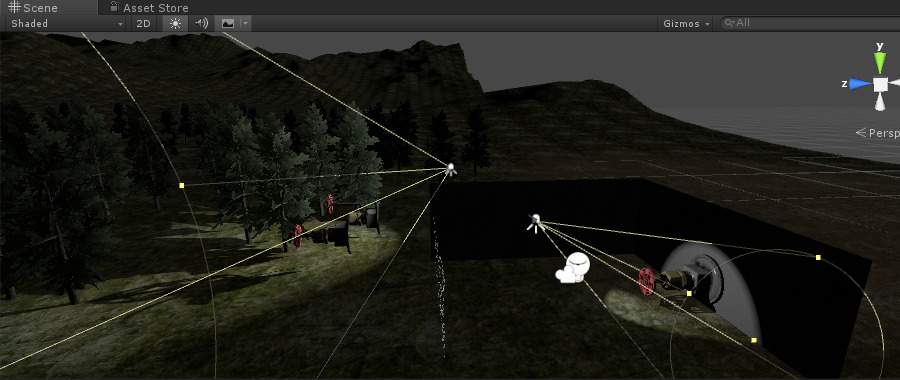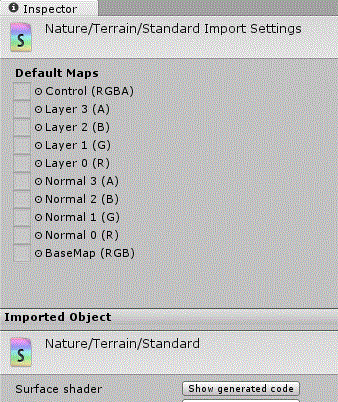The Lab Renderer for Unity是Valve针对VR在Unity的体验渲染器,提高VR的渲染效率,更多的大家可以查相应资料,在这,说个The Lab Renderer for Unity现阶段的问题,可能是第一版,在地形并不能接受Valve渲染产生的阴影,对应地形上的树啥的也不能产生阴影,经过相应修改后,如下是改动后的效果图。

我们首先需要分析下Lab Renderer的基本渲染流程,主要代码在ValveCamera中,可以看到,渲染流程还是很简单的,相应的Lab Renderer文档也首先点明了,前向单通道渲染。
我们知道在以前如Ogre2.0以前的前向渲染时,如果有多个灯光,是需要多次PASS来叠加光源得到效果,嗯,Unity本身也是这样处理的,这样灯光越多,灯光与模型就是L*M的关系,所以大家开始采用后向渲染,把模型相应数据渲染到GBuffer中,然后与光源计算得到正确显示,只需要L+M,虽然延迟渲染解决了多光源的问题,但是如下透明度,硬件AA,复杂材质,大量带宽是延迟渲染比较难搞的部分。
而在VR中,延迟渲染前没有比较好用的空间AA算法,一般来说在VR中,采用后向抗锯齿算法,一些UI还有字体还是还看到锯齿,而VR眼睛分辨率比主机高的多,GBuffer你搞低了效果不好,大一点,双摄像头需要的显存带宽更是比主机多了去,所以当你导入Stream VR的包时,都会让你选择前向渲染,嗯,前向渲染的问题前面说了,多光源,而ValveCamera主要就是来解决如何在前向渲染里的单Pass里渲染多个光源的。
Lab Renderer会要求你在每个实时光源下挂一个ValveRealtimeLight脚本,这个脚本主要是收集所有实时光源,然后在渲染时做二件事情,都是在OnPreCull之前,一是生成光源阴影图(RenderShadowBuffer),二是把所有灯光的信息填入到vr_lighting.cginc中的ValveVrLighting的const buffer中。
在以每个光源位置与方向来渲染当前的模型来生成阴影,不同类型光源会有些不同,如方向光,位置移到老后面,FOV也需要调整,肯定要保证所有模型都渲染到,而Point光源,需要渲染六个面,只有spot光源,其属性与Camera对应,不需要啥特殊处理,渲染的RenderTarget只需要一个差不多类似深度的值就行了,所有RenderTarget全在m_shadowDepthTexture中,根据在每个ValveRealtimeLight脚本中设置的大小自动选择一个位置,注意在场景中的任何地方不能有摄像机视野内的所有光源的ValveRealtimeLight设置的大小加起来不能超过m_shadowDepthTexture本身的大小。
然后就是写入所有灯光的信息到ValveVrLighting的const buffer中,在UpdateLightConstants这个方法中,其实这个过程和Ogre2.1的灯光处理很类似,大家可以看我以前写的 Ogre2.1 灯光与阴影,当然Ogre2.1会复杂的多,采用的是Forward+,会把屏幕分成N多小格,每个小格确定受到那些光源的影响,不过思路确实有很多是一样的。
明白了Lab Renderer做了啥,我们才开始做最主要的部分,替换地形着色器的代码,使之采用上面的m_shadowDepthTexture来产生阴影,并去掉原来的光照计算,采用Lab Renderer的光照算法,注意在这,我们还是想要能够使用Unity本身的地形编辑器,所以我们并不是简单把地形着色器有材质改成使用Custom,我们需要替换他本身的Standard地形着色器代码,在Unity5以后,对应shader文件为Standard-FirstPass.shader,我们要做的就是,把Standard-FirstPass.shader与vr_standard.shader终合起来,地形表面的颜色采用的Standard-FirstPass.shader里的SplatmapMix方法,而阴影以及光源影响在vr_standard.shader中的ComputeLighting方法。
需要注意的,Standard-FirstPass.shader本身做为SurfaceShader,提供的Input并不满足我们ComputeLighting想要的参数,所以我们需要先看下Standard-FirstPass.shader生成完整的,包含顶点,片断着色器的代码,如下最下面的按钮:

注意,产生的文件会有很多Pass,如每种Fog对应不同的Pass,在这我们只需要一个Pass就够了,其中Fog也让Lab Renderer里的vr_standard.shader中的处理方法来处理。
我们根据vr_standard.shader开始改造我们选择的一个Pass,首先我们要确认vr_standard.shader有那些预处理定义与相应操作是我们根本不需要的,或者是在地形中默认处理方式,可以简化大部分vr_standard.shader片断着色器中的代码,移除Standard-FirstPass.shader大部分片断着色器代码,添加vr_standard.shader片断着色器的代码,如前面所说,处理好Standard-FirstPass.shader里的SplatmapMix方法与vr_standard.shader中的ComputeLighting方法就成功了99%。如下是处理后的版本,还有Fog这边没有测试,大家自己去改,不麻烦。
文件链接:vr_terrain.zip

Shader "Nature/Terrain/Standard" { Properties{ // set by terrain engine [HideInInspector] _Control("Control (RGBA)", 2D) = "red" {} [HideInInspector] _Splat3("Layer 3 (A)", 2D) = "white" {} [HideInInspector] _Splat2("Layer 2 (B)", 2D) = "white" {} [HideInInspector] _Splat1("Layer 1 (G)", 2D) = "white" {} [HideInInspector] _Splat0("Layer 0 (R)", 2D) = "white" {} [HideInInspector] _Normal3("Normal 3 (A)", 2D) = "bump" {} [HideInInspector] _Normal2("Normal 2 (B)", 2D) = "bump" {} [HideInInspector] _Normal1("Normal 1 (G)", 2D) = "bump" {} [HideInInspector] _Normal0("Normal 0 (R)", 2D) = "bump" {} [HideInInspector][Gamma] _Metallic0("Metallic 0", Range(0.0, 1.0)) = 0.0 [HideInInspector][Gamma] _Metallic1("Metallic 1", Range(0.0, 1.0)) = 0.0 [HideInInspector][Gamma] _Metallic2("Metallic 2", Range(0.0, 1.0)) = 0.0 [HideInInspector][Gamma] _Metallic3("Metallic 3", Range(0.0, 1.0)) = 0.0 [HideInInspector] _Smoothness0("Smoothness 0", Range(0.0, 1.0)) = 1.0 [HideInInspector] _Smoothness1("Smoothness 1", Range(0.0, 1.0)) = 1.0 [HideInInspector] _Smoothness2("Smoothness 2", Range(0.0, 1.0)) = 1.0 [HideInInspector] _Smoothness3("Smoothness 3", Range(0.0, 1.0)) = 1.0 // used in fallback on old cards & base map [HideInInspector] _MainTex("BaseMap (RGB)", 2D) = "white" {} [HideInInspector] _Color("Main Color", Color) = (1,1,1,1) } SubShader{ Tags{ "Queue" = "Geometry-100" "RenderType" = "Opaque" "PerformanceChecks" = "False" } Pass { Name "FORWARD" Tags{ "LightMode" = "ForwardBase" "PassFlags" = "OnlyDirectional" } // NOTE: "OnlyDirectional" prevents Unity from baking dynamic lights into SH terms at runtime CGPROGRAM #pragma target 5.0 #pragma only_renderers d3d11 #pragma exclude_renderers gles #pragma vertex MainVs #pragma fragment MainPs #pragma shader_feature S_RECEIVE_SHADOWS #pragma multi_compile _ D_VALVE_SHADOWING_POINT_LIGHTS #pragma shader_feature S_OVERRIDE_LIGHTMAP #pragma multi_compile LIGHTMAP_OFF LIGHTMAP_ON #pragma multi_compile DIRLIGHTMAP_OFF DIRLIGHTMAP_COMBINED DIRLIGHTMAP_SEPARATE #pragma multi_compile DYNAMICLIGHTMAP_OFF DYNAMICLIGHTMAP_ON // Includes ------------------------------------------------------------------------------------------------------------------------------------------------- #include "UnityCG.cginc" #include "UnityLightingCommon.cginc" #include "UnityStandardUtils.cginc" #include "UnityStandardInput.cginc" #define S_RECEIVE_SHADOWS 1 #define D_VALVE_SHADOWING_POINT_LIGHTS 1 #include "Lighting.cginc" #pragma multi_compile __ _TERRAIN_NORMAL_MAP #define TERRAIN_STANDARD_SHADER #define TERRAIN_SURFACE_OUTPUT SurfaceOutputStandard #include "TerrainSplatmapCommon.cginc" #include "vr_utils.cginc" #include "vr_lighting.cginc" #include "vr_matrix_palette_skinning.cginc" #include "vr_fog.cginc" #define LIGHTMAP_ON 1 #define DYNAMICLIGHTMAP_ON 1 #define DYNAMICLIGHTMAP_OFF 0 #define DIRLIGHTMAP_COMBINED 1 #define S_OVERRIDE_LIGHTMAP 0 half _Metallic0; half _Metallic1; half _Metallic2; half _Metallic3; half _Smoothness0; half _Smoothness1; half _Smoothness2; half _Smoothness3; // Structs -------------------------------------------------------------------------------------------------------------------------------------------------- struct VS_INPUT { float4 vPositionOs : POSITION; float3 vNormalOs : NORMAL; float2 vTexCoord0 : TEXCOORD0; float2 vTexCoord1 : TEXCOORD1; #if ( DYNAMICLIGHTMAP_ON || UNITY_PASS_META ) float2 vTexCoord2 : TEXCOORD2; #endif }; struct PS_INPUT { float4 vPositionPs : SV_Position; float3 vPositionWs : TEXCOORD0; float3 vNormalWs : TEXCOORD1; float2 vTextureCoords : TEXCOORD2; float4 vLightmapUV : TEXCOORD3; float2 vFogCoords : TEXCOORD4; float4 pack0 : TEXCOORD5; // _Splat0 _Splat1 float4 pack1 : TEXCOORD6; // _Splat2 _Splat3 float2 custompack0 : TEXCOORD7; // tc_Control }; float g_flValveGlobalVertexScale = 1.0; // Used to "hide" all valve materials for debugging // World-aligned texture float3 g_vWorldAlignedTextureSize = float3(1.0, 1.0, 1.0); float3 g_vWorldAlignedNormalTangentU = float3(-1.0, 0.0, 0.0); float3 g_vWorldAlignedNormalTangentV = float3(0.0, 0.0, 1.0); float3 g_vWorldAlignedTexturePosition = float3(0.0, 0.0, 0.0); float4 _Splat0_ST; float4 _Splat1_ST; float4 _Splat2_ST; float4 _Splat3_ST; // MainVs --------------------------------------------------------------------------------------------------------------------------------------------------- PS_INPUT MainVs(appdata_full i) { PS_INPUT o = (PS_INPUT)0; UNITY_SETUP_INSTANCE_ID(i); UNITY_TRANSFER_INSTANCE_ID(v, o); Input customInputData; SplatmapVert(i, customInputData); o.custompack0.xy = customInputData.tc_Control; float3 vPositionWs = mul(unity_ObjectToWorld, i.vertex).xyz; o.vPositionWs.xyz = vPositionWs.xyz; o.vPositionPs.xyzw = mul(UNITY_MATRIX_MVP, i.vertex.xyzw); // Normal float3 vNormalWs = UnityObjectToWorldNormal(i.normal); o.vNormalWs.xyz = vNormalWs.xyz; #if ( LIGHTMAP_ON ) o.vLightmapUV.xy = i.texcoord1.xy * unity_LightmapST.xy + unity_LightmapST.zw; #endif #if ( DYNAMICLIGHTMAP_ON ) o.vLightmapUV.zw = i.texcoord2.xy * unity_DynamicLightmapST.xy + unity_DynamicLightmapST.zw; #endif o.vFogCoords.xy = CalculateFogCoords(vPositionWs.xyz); o.pack0.xy = TRANSFORM_TEX(i.texcoord, _Splat0); o.pack0.zw = TRANSFORM_TEX(i.texcoord, _Splat1); o.pack1.xy = TRANSFORM_TEX(i.texcoord, _Splat2); o.pack1.zw = TRANSFORM_TEX(i.texcoord, _Splat3); return o; } // MainPs --------------------------------------------------------------------------------------------------------------------------------------------------- struct PS_OUTPUT { float4 vColor : SV_Target0; }; PS_OUTPUT MainPs(PS_INPUT i) { PS_OUTPUT po = (PS_OUTPUT)0; Input surfIN; UNITY_INITIALIZE_OUTPUT(Input, surfIN); surfIN.uv_Splat0.x = 1.0; surfIN.uv_Splat1.x = 1.0; surfIN.uv_Splat2.x = 1.0; surfIN.uv_Splat3.x = 1.0; surfIN.tc_Control.x = 1.0; surfIN.uv_Splat0 = i.pack0.xy; surfIN.uv_Splat1 = i.pack0.zw; surfIN.uv_Splat2 = i.pack1.xy; surfIN.uv_Splat3 = i.pack1.zw; surfIN.tc_Control = i.custompack0.xy; half4 splat_control; half weight; fixed4 mixedDiffuse; half4 defaultSmoothness = half4(_Smoothness0, _Smoothness1, _Smoothness2, _Smoothness3); SplatmapMix(surfIN, defaultSmoothness, splat_control, weight, mixedDiffuse, i.vNormalWs); //mixedDiffuse.rgb;weight;mixedDiffuse.a;dot(splat_control, half4(_Metallic0, _Metallic1, _Metallic2, _Metallic3)); float3 vAlbedo = mixedDiffuse.rgb; float3 vTangentUWs = float3(1.0, 0.0, 0.0); float3 vTangentVWs = float3(0.0, 1.0, 0.0); float3 vGeometricNormalWs = float3(0.0, 0.0, 1.0); i.vNormalWs.xyz = normalize(i.vNormalWs.xyz); vGeometricNormalWs.xyz = i.vNormalWs.xyz; float3 vNormalWs = vGeometricNormalWs.xyz; float3 vNormalTs = float3(0.0, 0.0, 1.0); // Roughness // float2 vRoughness = float2(0.6, 0.6); // Reflectance and gloss float3 vReflectance = float3(0.0, 0.0, 0.0); float flGloss = 0.0; vRoughness.xy = (1.0 - flGloss).xx; LightingTerms_t lightingTerms; lightingTerms.vDiffuse.rgb = float3(1.0, 1.0, 1.0); lightingTerms.vSpecular.rgb = float3(0.0, 0.0, 0.0); lightingTerms.vIndirectDiffuse.rgb = float3(0.0, 0.0, 0.0); lightingTerms.vIndirectSpecular.rgb = float3(0.0, 0.0, 0.0); lightingTerms.vTransmissiveSunlight.rgb = float3(0.0, 0.0, 0.0); float flFresnelExponent = 5.0; float flMetalness = 0.2f; float4 vLightmapUV = float4(0.0, 0.0, 0.0, 0.0); #if (LIGHTMAP_ON || DYNAMICLIGHTMAP_ON ) vLightmapUV.xy = i.vLightmapUV.xy; #if ( DYNAMICLIGHTMAP_ON ) vLightmapUV.zw = i.vLightmapUV.zw; #endif // Compute lighting lightingTerms = ComputeLighting(i.vPositionWs.xyz, vNormalWs.xyz, vTangentUWs.xyz, vTangentVWs.xyz, vRoughness.xy, vReflectance.rgb, flFresnelExponent, vLightmapUV.xyzw); #if ( S_OCCLUSION ) float flOcclusion = tex2D(_OcclusionMap, i.vTextureCoords.xy).g; lightingTerms.vDiffuse.rgb *= LerpOneTo(flOcclusion, _OcclusionStrength * _OcclusionStrengthDirectDiffuse); lightingTerms.vSpecular.rgb *= LerpOneTo(flOcclusion, _OcclusionStrength * _OcclusionStrengthDirectSpecular); lightingTerms.vIndirectDiffuse.rgb *= LerpOneTo(flOcclusion, _OcclusionStrength * _OcclusionStrengthIndirectDiffuse); lightingTerms.vIndirectSpecular.rgb *= LerpOneTo(flOcclusion, _OcclusionStrength * _OcclusionStrengthIndirectSpecular); #endif #endif // Diffuse po.vColor.rgb = (lightingTerms.vDiffuse.rgb + lightingTerms.vIndirectDiffuse.rgb) * vAlbedo.rgb; po.vColor.rgb += lightingTerms.vIndirectSpecular.rgb; // Indirect specular applies its own fresnel in the forward lighting header file //po.vColor.rgb = lightingTerms.vDiffuse.rgb; po.vColor.a = mixedDiffuse.a; // Emission - Unity just adds the emissive term at the end instead of adding it to the diffuse lighting term. Artists may want both options. //float3 vEmission = Emission(i.vTextureCoords.xy); //po.vColor.rgb += vEmission.rgb; //o.vColor.rgb = ApplyFog(o.vColor.rgb, i.vFogCoords.xy, _FogMultiplier); // Dither to fix banding artifacts //po.vColor.rgb = ScreenSpaceDither(i.vPositionPs.xy); return po; } ENDCG } } Fallback "Nature/Terrain/Diffuse" }
地形中的树开始很奇怪,为啥没有投射阴影,在RenderShadowBuffer时调用m_shadowCamera.RenderWithShader时,在Frame Debug中发现并没有把树加进来,后面把渲染树的shader找到看了下,发现RenderType都不是Opaque,那么一是改变相应树的shader,使RenderType为Opaque,二是直接在RenderWithShader第二个参数填string.Empty就行,这样会有一个问题,会把啥透明的都渲染进来。
其中vr_standard.shader与Standard-FirstPass.shader针对地形的混合,只是能看到阴影,如果想用,肯定还是要针对性的修改才行。
